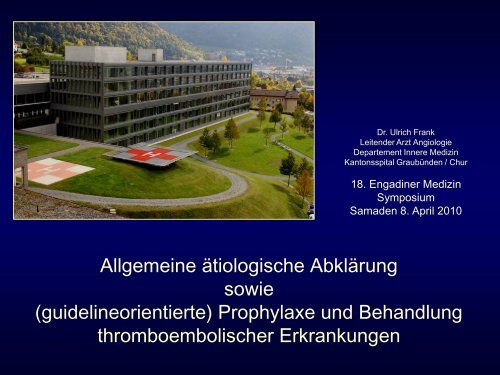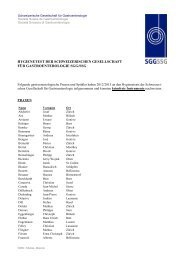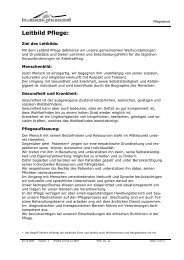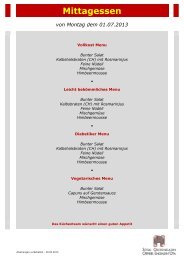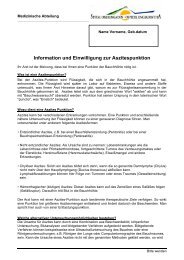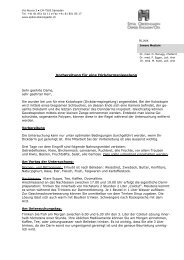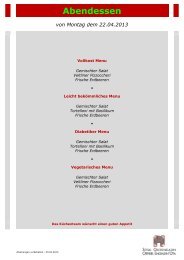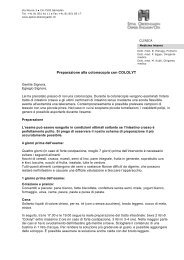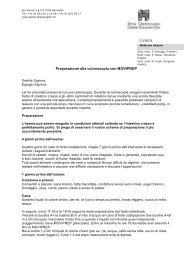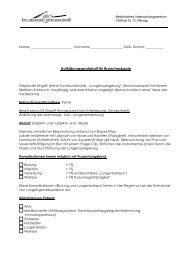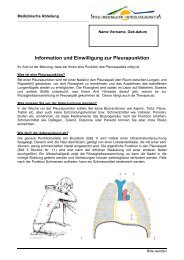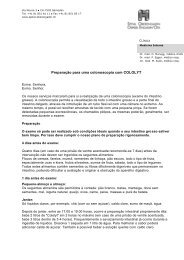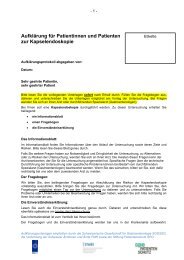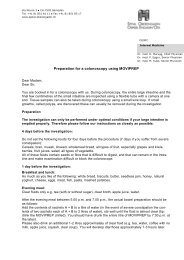idiopathische Thrombosen - Spital Oberengadin
idiopathische Thrombosen - Spital Oberengadin
idiopathische Thrombosen - Spital Oberengadin
Sie wollen auch ein ePaper? Erhöhen Sie die Reichweite Ihrer Titel.
YUMPU macht aus Druck-PDFs automatisch weboptimierte ePaper, die Google liebt.
Dr. Ulrich Frank<br />
Leitender Arzt Angiologie<br />
Departement Innere Medizin<br />
Kantonsspital Graubünden / Chur<br />
18. Engadiner Medizin<br />
Symposium<br />
Samaden 8. April 2010<br />
Allgemeine ätiologische Abklärung<br />
sowie<br />
(guidelineorientierte) Prophylaxe und Behandlung<br />
thromboembolischer Erkrankungen
Jährliche Inzidenz von <strong>Thrombosen</strong> in der Bevölkerung<br />
1:1000
Alterskorrigierte Thrombosehäufigkeit<br />
pro 100000 in der Normalbevölkerung
Alterskorrigierte Thrombosehäufigkeit<br />
pro 100000 in der Normalbevölkerung<br />
Mann > Frau
Alterskorrigierte Thrombosehäufigkeit<br />
pro 100000 in der Normalbevölkerung<br />
1:1000
<strong>Thrombosen</strong> mit<br />
bekannter Genese
Bekannte Risikofaktoren für <strong>Thrombosen</strong><br />
Alter<br />
Geschlecht<br />
Adipositas<br />
Orale Antikonzeption<br />
Schwangerschaft<br />
Immobilisation / Lähmungen<br />
Operationen<br />
Trauma<br />
Internistische Erkrankungen<br />
(Herzinsuffizienz, nephrot. Syndrom, Leberzirrhose)<br />
Tumorerkrankungen
<strong>Thrombosen</strong> mit<br />
bekannter Genese<br />
<strong>idiopathische</strong><br />
<strong>Thrombosen</strong>
<strong>Thrombosen</strong> mit<br />
bekannter Genese<br />
<strong>idiopathische</strong><br />
<strong>Thrombosen</strong><br />
hereditäre<br />
Thrombophilien
Alterskorrigierte Thrombosehäufigkeit<br />
pro 100000 in der Normalbevölkerung
Alterskorrigierte Thrombosehäufigkeit<br />
pro 100000 in der Normalbevölkerung<br />
Thrombophilie ?
<strong>Thrombosen</strong> mit<br />
bekannter Genese<br />
<strong>idiopathische</strong><br />
<strong>Thrombosen</strong>
<strong>Thrombosen</strong> mit<br />
bekannter Genese<br />
<strong>idiopathische</strong><br />
<strong>Thrombosen</strong><br />
?<br />
Thrombophilie als modulierender Faktor
Überlegungen zur Therapie<br />
der <strong>Thrombosen</strong>
<strong>Thrombosen</strong> mit<br />
bekannter Genese<br />
<strong>idiopathische</strong><br />
<strong>Thrombosen</strong><br />
hereditäre<br />
Thrombophilien
Therapie der Thrombose<br />
Rezidiv-Thrombose<br />
Klinisch relevante Blutung
Einflussfaktoren auf die Behandlungsrisiken<br />
Alter<br />
Geschlecht<br />
Begleiterkrankungen<br />
Begleitmedikation<br />
Therapieform<br />
Therapiedauer<br />
Therapieintensität
<strong>Thrombosen</strong> mit<br />
bekannter Genese<br />
<strong>idiopathische</strong><br />
<strong>Thrombosen</strong><br />
hereditäre<br />
Thrombophilien
Einflussfaktoren auf die Behandlungsrisiken<br />
Alter<br />
Geschlecht<br />
Begleiterkrankungen<br />
Begleitmedikation<br />
Therapieform<br />
Therapiedauer<br />
Therapieintensität
<strong>Thrombosen</strong> mit<br />
bekannter Genese
Rezidiv-Thrombose<br />
Klinisch relevante Blutung<br />
In der Regel<br />
kalkulierbares<br />
Rezidivrisiko<br />
Blutungsrisiko<br />
steigt mit<br />
Therapiedauer
Intensität der OAK und Risk / Benefit - Ratio
Rezidiv - Raten für VTE – Ereignisse bei OAK
(1.5 %) (3 %)
Blutungsrisiken von Kombinationen aus TAH und OAK<br />
R. Sorensen et al. The Lancet Vol 374 December 12, 2009
Therapiedauer 3 - 6 Monate
<strong>Thrombosen</strong> mit<br />
bekannter Genese<br />
<strong>idiopathische</strong><br />
<strong>Thrombosen</strong><br />
?<br />
Thrombophilie als modulierender Faktor
Thrombophiliediagnostik
Hereditary thrombophilia<br />
These disorders should be suspected<br />
if the patient has a history of recurrent venous thromboembolism,<br />
a venous thrombosis occurring in a person younger than 40 years,<br />
a familial history of venous thromboembolism or thrombosis at an unusual<br />
site (eg, mesenteric vein, renal vein, hepatic and cerebral thrombosis).<br />
Purpura fulminans in infancy could suggest protein C deficiency.<br />
Thrombophilic disorders are usually associated with venous thrombosis.<br />
However, protein S, protein C, and ATIII deficiencies have been rarely<br />
associated with arterial thrombosis.<br />
http://emedicine.medscape.com/article/211039-print
Clinical criteria for indicating the presence of lupus anticoagulants<br />
(Sapporo criteria for the antiphospholipid syndrome) :<br />
One or more arterial, venous, or small vessel thrombosis,<br />
affecting any organ or tissue<br />
Pregnancy morbidity (10th wk or later)<br />
increases the risk for maternal and fetal morbidity and<br />
fetal mortality in pregnancy [spontaneous abortions, prematurity, stillbirths])<br />
Three or more unexplained consecutive spontaneous abortions<br />
before the 10th week of gestation<br />
http://emedicine.medscape.com/article/211039-print
Prävalenz
Condition<br />
Factor V<br />
Leiden<br />
Prothrombin<br />
20210A<br />
Prevalence in General<br />
Population, %<br />
Relative Risk<br />
of VTE, %<br />
Relative Risk of<br />
Recurrent VTE, %<br />
3-7 4.3 1.3<br />
1-3 1.9 1.4<br />
Protein C 0.02-0.05 11.3 2.5<br />
Protein S 0.01-1 32.4 2.5<br />
Antithrombin<br />
III<br />
0.02-0.04 17.5 2.5<br />
Heit JA. Thrombophilia: common questions on laboratory assessment and management.<br />
Hematology Am Soc Hematol Educ Program. 2007;127-35.
Condition<br />
Factor V<br />
Leiden<br />
Prothrombin<br />
20210A<br />
Prevalence in General<br />
Population, %<br />
Relative Risk<br />
of VTE, %<br />
Relative Risk of<br />
Recurrent VTE, %<br />
3-7 4.3 1.3<br />
1-3 1.9 1.4<br />
Protein C 0.02-0.05 11.3 2.5<br />
Protein S 0.01-1 32.4 2.5<br />
Antithrombin<br />
III<br />
0.02-0.04 17.5 2.5<br />
Heit JA. Thrombophilia: common questions on laboratory assessment and management.<br />
Hematology Am Soc Hematol Educ Program. 2007;127-35.
<strong>Thrombosen</strong> mit<br />
bekannter Genese<br />
<strong>idiopathische</strong><br />
<strong>Thrombosen</strong><br />
hereditäre<br />
Thrombophilien
Rezidiv-Thrombose<br />
Klinisch relevante Blutung<br />
Unterschiedlich<br />
hohes Rezidivrisiko<br />
Blutungsrisiko<br />
steigt mit<br />
Therapiedauer
Condition<br />
Factor V<br />
Leiden<br />
Prothrombin<br />
20210A<br />
Prevalence in General<br />
Population, %<br />
Relative Risk<br />
of VTE, %<br />
Relative Risk of<br />
Recurrent VTE, %<br />
3-7 4.3 1.3<br />
1-3 1.9 1.4<br />
Protein C 0.02-0.05 11.3 2.5<br />
Protein S 0.01-1 32.4 2.5<br />
Antithrombin<br />
III<br />
0.02-0.04 17.5 2.5<br />
Heit JA. Thrombophilia: common questions on laboratory assessment and management.<br />
Hematology Am Soc Hematol Educ Program. 2007;127-35.
Relative Rezidivrisiken bei <strong>idiopathische</strong>r Thrombose
Relative Rezidivrisiken bei <strong>idiopathische</strong>r Thrombose
Männer Rezidivrisiko : 13.7 % p.a.<br />
Frauen (Low Risk) : 1.6 % p.a.<br />
Frauen (High Risk)<br />
: 14.1 % p.a.
Mittleres Rezidivrisiko : 9.3 % p.a.
Studienziel:<br />
Suche nach Faktoren zur Risikostratifizierung<br />
Low risk < 3 % , high risk > 3 %<br />
jährliches Rezidivrisko
D-Dimer Messung unter laufender Antikoagulation
Männer Rezidivrisiko : 13.7 % p.a.<br />
Frauen (Low Risk) : 1.6 % p.a.<br />
Frauen (High Risk)<br />
: 14.1 % p.a.
Rezidiv - Raten für VTE – Ereignisse bei OAK
(1.5 %) (3 %)
RIVAROXABAN<br />
NO<br />
NO
Vitamin K Antagonisten (Faktor II,IV,IX,X)<br />
NO<br />
NO<br />
NO<br />
NO
Guideline-orientierte<br />
Thromboseprophylaxe und Therapie
SMF 2005
2005<br />
2004
2008
+++<br />
++<br />
+<br />
+/-<br />
_
ACCP 2008<br />
Allgemeine Empfehlungen<br />
zur Thromboseprophylaxe und Therapie
Aspirin hat kein Indikation<br />
in der Thromboseprophylaxe
Ausgangs-Thrombozytenzahl<br />
zu Beginn der ( LMW-) Heparintherapie<br />
empfohlen (1C)<br />
Bei Frühreaktion auf Heparingabe<br />
sofortige Thrombozytenmessung<br />
empfohlen
Unter Fondaparinux keine<br />
Thrombozytenkontrolle erforderlich
Laborkontrollen<br />
nur bei fortgeschrittener Niereninsuffizienz<br />
Bei CrCl < 30 – Dosis halbieren<br />
Keine Routine-Laborkontrollen<br />
unter LMW-Heparinen
Hirudine / Hirudinoide<br />
Labormonitoring (aPTT) bei Patienten mit<br />
CrCl 30-60<br />
CrCl < 30 Lepirudin und Desirudin nicht<br />
empfohlen<br />
Keine 2. Anwendung von Lepirudin und<br />
Desirudin wg. mögl. anaphylakt. Reaktion<br />
Monitoring Argatroban<br />
mit FXa Aktivitätsmessung<br />
(Indikation HIT II)<br />
(Thrombin ,FIIa)
Beachtung der Nierenfunktion<br />
bei Gabe von<br />
LMWH, Fondaparinux und anderen<br />
antithrombotischen Medikamenten, die<br />
über die Nieren ausgeschieden werden.<br />
Empfehlung: Vermeidung, Dosisreduktion,<br />
Drug-Monitoring
Bei stark schwankenden INR Werten<br />
unter VKA – Versuch der niedrigdosierten<br />
Vitamin K Substitution (2B)
Antiphospholipid-Syndrom<br />
Unproblematisch – INR 2-3<br />
Bei Komplikationen – INR 2.5-3.5
Mechanische Thromboseprophylaxe in<br />
erster Linie bei Blutungsrisiko-Patienten<br />
(2A)
Schriftliches <strong>Spital</strong>konzept zur<br />
Thromboseprophylaxe<br />
und<br />
Massnahmen zur Verbesserung der<br />
Umsetzung der Guideline-Empfehlungen<br />
empfohlen
ACCP 2008 Empfehlungen<br />
zur situationsbezogenen Thromboseprophylaxe
Thromboseprophylaxe<br />
Inneren Medizin<br />
Bettlägerige Patienten mit >1 RF<br />
LMWH , Fondaparinux,<br />
low dose UFH (alle 1A)<br />
Bei Kontraindikationen gegen<br />
Pharmakoprophylaxe –<br />
Optimale mechanische Prophylaxe<br />
GCS +/- IPC (1A)
Thromboseprophylaxe<br />
Onkologie<br />
Bei OP : entsprechend Guideline<br />
Bei Bettlägerigkeit :<br />
Standard-Prophylaxe Innere Medizin (1A)<br />
Keine Prophylaxe bei zentralen Kathetern<br />
zum Schutz vor Katheterthrombose (1B)<br />
Unter Chemotherapie: keine Routine-<br />
Prophylaxe (1C)<br />
Keine Primär-Prophylaxe mit dem Ziel<br />
einer Lebenszeitverlängerung (1B)
Thromboseprophylaxe<br />
Intensivmedizin<br />
LMWH oder low dose UFH (1A)<br />
Hochrisikopatienten<br />
LMWH (1A)<br />
Bei Kontraindikationen gegen<br />
Pharmakoprophylaxe –<br />
Optimale mechanische Prophylaxe<br />
GCS +/- IPC (1A)<br />
Sobald Blutungsrisiko kontrolliert –<br />
Kombination mit Pharmakoprophylaxe (1C)
Thromboseprophylaxe<br />
Allgemeinchirurgie<br />
Low risk -- Mobilisation<br />
Intermediate und High Risk:<br />
Prophylaxe mit<br />
LMWH, Fondaparinux,<br />
low dose UFH (1A)
Thromboseprophylaxe<br />
Allgemeinchirurgie<br />
Sehr hohes Risiko<br />
Kombination Pharmakotherapie mit<br />
mechanischer Prophylaxe (GCS,IPC)
Thromboseprophylaxe<br />
Laparaskopischer Chirurgie<br />
Low Risk -- Frühe Mobilisation (1B)<br />
Laparoskopische OP mit RF:<br />
Prophylaxe mit<br />
LMWH, Fondaparinux,<br />
low dose UFH oder GCS (1C)
Thromboseprophylaxe<br />
Urologie<br />
Transurethrale oder Low Risk Eingriffe:<br />
Frühmobilisation<br />
Für grössere urologische Eingriffe:<br />
Prophylaxe mit<br />
UFH in 2-3 Dosen/d (1B) + GCS/IPC (1B)<br />
Beginn direkt vor OP,<br />
Dauer bis zur Mobilisation<br />
Bei Blutungen oder hohem Risiko :<br />
Mechanische Thromboseprophylaxe (1A),<br />
sobald Blutung kontrolliert – UFH (1A)
Thromboseprophylaxe<br />
Kniearthroskopie<br />
Low Risk -- Frühe Mobilisation (2B)<br />
Arthroskopische OP<br />
mit RF / Komplikationen:<br />
Prophylaxe mit LMWH (1B)
Thromboseprophylaxe -Timing in der<br />
grösseren orthopädischen Chirurgie<br />
LMWH<br />
eher erst postoperativ (1A)<br />
Fondaparinux<br />
(FXa-Antagonist) eher erst 6-8 h post-OP<br />
oder am OP-Folgetag
Thromboseprophylaxe-Dauer<br />
grössere orthopädische Chirurgie<br />
wenigstens 10 Tage post OP (1A)<br />
Nach totalem Hüftersatz<br />
bis zum 35. post-OP Tag (1A):<br />
LMWH (1A), VKA (1B), Fondaparinux (1C)<br />
Nach totalem Knieersatz<br />
bis zum 35. post-OP Tag (2B):<br />
LMWH (1C), VKA (1C), Fondaparinux (1C)<br />
Nach Hüftfraktur-OP<br />
bis zum 35. post-OP Tag (1A):<br />
LMWH (1C), VKA (1C), Fondaparinux (1A)
Thromboseprophylaxe<br />
Unfall-Chirurgie (Hüftfraktur)<br />
Fondaparinux (1A)<br />
LMWH (1B)<br />
VKA mit Ziel INR 2-3 (1B)<br />
Nicht empfohlen als alleinige Prophylaxe:<br />
ASS (1A)<br />
Beginn der Prophylaxe schon prae-op, falls<br />
OP nicht direkt nach Aufnahme<br />
Falls hohes Blutungsrisiko – mechanische<br />
Prophylaxe (1A). Sobald Blutungsrisiko<br />
sich reduziert – Kombination mit<br />
Pharmakoprophylaxe empfohlen (1C)
Thromboseprophylaxe<br />
elektive Wirbelsäuleneingriffe<br />
Low Risk -- Frühe Mobilisation (2C)<br />
OP mit zusätzlichen RF:<br />
Low dose UFH (1B)<br />
LMWH (1B)<br />
IPC (1B)<br />
GCS (2B)<br />
Bei multiplen RF:<br />
Kombination IPC +/- GCS mit<br />
Low dose UFH oder LMWH
Thromboseprophylaxe<br />
Neurochirurgie<br />
IPC (1A)<br />
LMWH (2A)<br />
low dose UFH (2B)<br />
Bei hohem Risiko:<br />
Kombination IPC +/- GCS mit<br />
Low dose UFH oder LMWH
Thromboseprophylaxe<br />
Gynäkologie<br />
Minor procedure and low risk --<br />
Mobilisation<br />
Endoskopische OP ohne weitere RF:<br />
nur Mobilisation<br />
Endoskopische OP mit RF:<br />
Prophylaxe mit<br />
LMWH, Fondaparinux,<br />
low dose UFH (1A)
Thromboseprophylaxe<br />
Gynäkologie<br />
Alle grösseren Eingriffe (benigne) :<br />
Prophylaxe mit<br />
LMWH, Fondaparinux,<br />
low dose UFH (1A)<br />
Beginn direkt vor OP,<br />
Dauer bis zur Mobilisation<br />
Alle grösseren Eingriffe (maligne) :<br />
Prophylaxe mit<br />
LMWH, Fondaparinux,<br />
low dose UFH (1A)<br />
Beginn direkt vor OP,<br />
Dauer mindestens bis zur Mobilisation /<br />
Entlassung (1C)<br />
evtl. sogar bis 28 Tage nach OP (2C)
Thromboseprophylaxe<br />
Reisemedizin<br />
Bei Flügen > 8 h<br />
lockere Kleidung<br />
adaequate Hydrierung<br />
häufige US-Muskelkontraktionen (alle 1C)<br />
Bei erhöhtem Risiko<br />
GCS (2C)<br />
oder<br />
einmalige LMWH Dosis vor Abreise (2C)<br />
Aspirin als Thromboseprophylaxe nicht<br />
empfohlen
ACCP 2008 Empfehlungen<br />
zur Thrombosetherapie
Thrombophlebitis<br />
prophylaktische oder<br />
intermediäre Dosen an<br />
LMWH oder UFH für > 4 Wochen<br />
alternativ OAK für 4 Wochen<br />
keine oralen Antiphlogistika dazu<br />
Medikamentöse Therapie eher als<br />
chirurgische Therapie empfohlen
Beinvenenthrombose<br />
Initiale Therapie mit<br />
UFH,LMWH,Fondaparinux<br />
für mindestens 5 Tage<br />
Bei Pat. mit hoher<br />
Vortestwahrscheinlichkeit<br />
Therapie bereits<br />
vor Bestätigung empfohlen<br />
s.c. Therapie bis INR<br />
bei 2 Kontrollen > 2<br />
paralleler Beginn OAK und<br />
s.c. Therapie empfohlen
Initiale Therapie mit<br />
LMWH,Fondaparinux s.c. 1 oder<br />
2x/d besser als i.v. UFH<br />
Keine Faktor Xa<br />
Routinekontrollen bei LMWH<br />
Bei Niereninsuffizienz besser<br />
UFH als LMWH
Frühmobilisation
<strong>Thrombosen</strong> mit<br />
bekannter Genese
Reversible Ursache --- > 3 Monate OAK
Behandlung thromboembolischer Ereignisse<br />
Initial LMW-Heparin > 5 d<br />
Parallel Beginn OAK Ziel INR 2-3
<strong>Thrombosen</strong> mit<br />
bekannter Genese<br />
<strong>idiopathische</strong><br />
<strong>Thrombosen</strong><br />
hereditäre<br />
Thrombophilien
2004
2008
Idiopathische Thrombose<br />
proximale TVT +<br />
keine Blutungsrisiken +<br />
gute Einstellung der Antikoagulation<br />
Empfehlung<br />
zur Dauerantikoagulation (1A)
Intensität der OAK und Risk / Benefit - Ratio
Blutungsrisiken von Kombinationen aus TAH und OAK<br />
R. Sorensen et al. The Lancet Vol 374 December 12, 2009
Sonderfälle
systemische Thrombolyse<br />
symptomat. Indikation
operative Thrombektomie<br />
Alternative zur Lyse<br />
aus symptomat. Indikation
Cavafilter<br />
nur in speziellen Situationen<br />
sobald möglich<br />
Kombination mit OAK
Vielen Dank<br />
für Ihre Aufmerksamkeit


